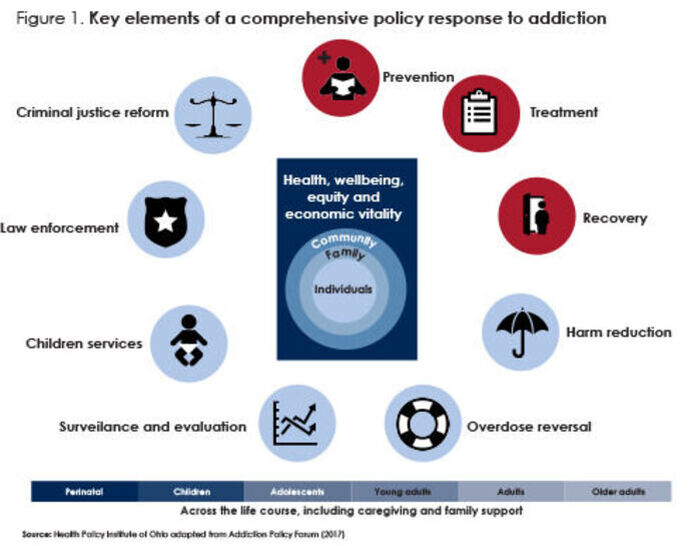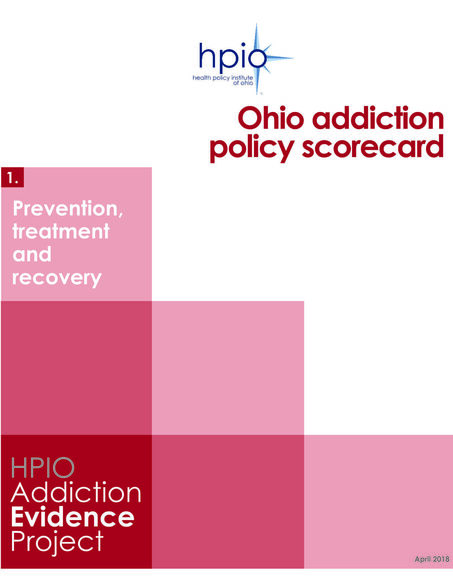Ohio addiction policy scorecard: Prevention, treatment and recovery
April 17, 2018
- Evidence resource page: Prevention, treatment and recovery
- Click here to view other phases of the Addiction Evidence Project
Publication graphics:
Webinar recording
- Click here to watch the webinar (recorded July 18, 2018)
This report is the first in a series of inventories and scorecards analyzing Ohio’s policy response to the addiction crisis and outlining areas where the state could be more effective.
The report provides policymakers and other stakeholders with the information needed to take stock of Ohio’s policy response to the addiction crisis over the past five years by reviewing state-level policy changes enacted in Ohio from 2013-2017. It includes:
- An inventory of policy changes (legislation, rules, regulations and new or expanded state agency initiatives, programs, systems changes or guidelines)
- A scorecard that indicates the extent to which Ohio is implementing strategies that are proven effective by research evidence
- Opportunities for improvement in both the public and private sectors
Click to enlarge
The report focuses on the first three elements of a comprehensive policy response to addiction: prevention, treatment and recovery. HPIO plans to develop similar inventories and scorecards for other key elements in 2018 and 2019 (see graphic in the right).
Click to enlarge
In 2016, 4,050 Ohioans died because of unintentional drug overdoses, and preliminary 2017 data indicates that the number of deaths has continued to rise.
The consequences of addiction are widespread. For example, the number of babies born with neonatal abstinence syndrome (NAS) increased 500 percent in the past 10 years and thousands of children experience trauma because they live in families struggling with addiction. Employers report difficulty hiring drug-free workers, and researchers estimate that the opioid crisis cost Ohio $3,385 per capita in healthcare and criminal justice spending and reduced worker productivity in 2015.
Public and private stakeholders have worked hard to understand and address the crisis. Policy changes advanced by the executive and legislative branches have led to implementation of many evidence-based programs in Ohio, reduced the amount of opioid prescriptions dispensed and increased health insurance coverage and treatment access for thousands of Ohioans through expanded Medicaid eligibility.
Although this report has a strong focus on prescription opioids and other opiates, the detailed inventory and scorecard (available below) also review policy changes related to several other substances (alcohol, tobacco, methamphetamine, cocaine, etc.).
The report is part HPIO’s Addiction Evidence Project, which provides policymakers and other stakeholders with information needed to address substance use disorders in a comprehensive, effective and efficient way. This inventory and scorecard addresses three topics: prevention, treatment and recovery. Future reports will address the other topics listed below, including overdose reversal (naloxone).


Correction
05.10.2018: The 2016 U.S. uninsured rate for adults ages 18-64 on page 26 of the full report and page 20 of the detailed scorecard was incorrect in the previous version of this publication. The correct rate is 7.4%. (Source: HPIO analysis of U.S. Census Bureau data. 2016 American Community Survey 1-year estimates, accessed through the American FactFinder. “Table B27001 – Health Insurance Coverage status by sex by age.” U.S. Census Bureau. Accessed Feb 14, 2018. https://factfinder.census.gov/bkmk/table/1.0/en/ACS/16_1YR/B27001)
Webinar: Ohio Addiction Policy Inventory and Scorecard: Prevention, Treatment and Recovery
By:
Amy Rohling McGee, MSW
Hailey Akah, JD, MA
Published On
April 17, 2018
 Download Publication
Download Publication
